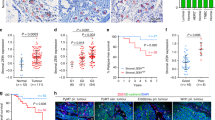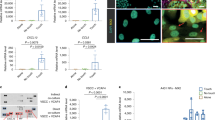Abstract
The co-evolution of tumors and their microenvironment involves bidirectional communication between tumor cells and tumor-associated stroma. Various cell types are present in tumor-associated stroma, of which fibroblasts are the most abundant. The Rac exchange factor Tiam1 is implicated in multiple signaling pathways in epithelial tumor cells and lack of Tiam1 in tumor cells retards tumor growth in Tiam1 knockout mouse models. Conversely, tumors arising in Tiam1 knockout mice have increased invasiveness. We have investigated the role of Tiam1 in tumor-associated fibroblasts as a modulator of tumor cell invasion and metastasis, using retroviral delivery of short hairpin RNA to suppress Tiam1 levels in three different experimental models. In spheroid co-culture of mammary epithelial cells and fibroblasts, Tiam1 silencing in fibroblasts led to increased epithelial cell outgrowth into matrix. In tissue-engineered human skin, Tiam1 silencing in dermal fibroblasts led to increased invasiveness of epidermal keratinocytes with pre-malignant features. In a model of human breast cancer in mice, co-implantation of mammary fibroblasts inhibited tumor invasion and metastasis, which was reversed by Tiam1 silencing in co-injected fibroblasts. These results suggest that stromal Tiam1 may have a role in modulating the effects of the tumor microenvironment on malignant cell invasion and metastasis. This suggests a set of pathways for further investigation, with implications for future therapeutic targets.
This is a preview of subscription content, access via your institution
Access options
Subscribe to this journal
Receive 50 print issues and online access
$259.00 per year
only $5.18 per issue
Buy this article
- Purchase on Springer Link
- Instant access to full article PDF
Prices may be subject to local taxes which are calculated during checkout






Similar content being viewed by others
References
Andriani F, Garfield J, Fusenig NE, Garlick JA . (2004). Basement membrane proteins promote progression of intraepithelial neoplasia in 3-dimensional models of human stratified epithelium. Int J Cancer 108: 348–357.
Baines AT, Lim KH, Shields JM, Lambert JM, Counter CM, Der CJ et al. (2006). Use of retrovirus expression of interfering RNA to determine the contribution of activated K-Ras and ras effector expression to human tumor cell growth. Methods Enzymol 407: 556–574.
Bhowmick NA, Chytil A, Plieth D, Gorska AE, Dumont N, Shappell S et al. (2004a). TGF-beta signaling in fibroblasts modulates the oncogenic potential of adjacent epithelia. Science 303: 848–851.
Bhowmick NA, Moses HL . (2005). Tumor–stroma interactions. Curr Opin Genet Dev 15: 97–101.
Bhowmick NA, Neilson EG, Moses HL . (2004b). Stromal fibroblasts in cancer initiation and progression. Nature 432: 332–337.
Boguski MS, McCormick F . (1993). Proteins regulating Ras and its relatives. Nature 366: 643–654.
Boukamp P, Stanbridge EJ, Foo DY, Cerutti PA, Fusenig NE . (1990). c-Ha-ras oncogene expression in immortalized human keratinocytes (HaCaT) alters growth potential in vivo but lacks correlation with malignancy. Cancer Res 50: 2840–2847.
Buchsbaum RJ . (2007). Rho activation at a glance. J Cell Sci 120: 1149–1152.
Connolly BA, Rice J, Feig LA, Buchsbaum RJ . (2005). Tiam1–IRSp53 complex formation directs specificity of rac-mediated actin cytoskeleton regulation. Mol Cell Biol 25: 4602–4614.
Cruz-Monserrate Z, O'Connor KL . (2008). Integrin alpha 6 beta 4 promotes migration, invasion through Tiam1 upregulation, and subsequent Rac activation. Neoplasia 10: 408–417.
Cunha GR, Donjacour AA . (1989). Mesenchymal–epithelial interactions in the growth and development of the prostate. Cancer Treat Res 46: 159–175.
Debnath J, Walker SJ, Brugge JS . (2003). Akt activation disrupts mammary acinar architecture and enhances proliferation in an mTOR-dependent manner. J Cell Biol 163: 315–326.
Erickson JW, Cerione RA . (2004). Structural elements, mechanism, and evolutionary convergence of Rho protein–guanine nucleotide exchange factor complexes. Biochemistry 43: 837–842.
Fusenig NE, Boukamp P . (1998). Multiple stages and genetic alterations in immortalization, malignant transformation, and tumor progression of human skin keratinocytes. Mol Carcinogen 23: 144–158.
Garlick JA . (2007). Engineering skin to study human disease—tissue models for cancer biology and wound repair. Adv Biochem Eng Biotechnol 103: 207–239.
Gupta GP, Massague J . (2006). Cancer metastasis: building a framework. Cell 127: 679–695.
Habets GG, Scholtes EH, Zuydgeest D, van der Kammen RA, Stam JC, Berns A et al. (1994). Identification of an invasion-inducing gene, Tiam-1, that encodes a protein with homology to GDP–GTP exchangers for Rho-like proteins. Cell 77: 537–549.
Hall A . (1998). Rho GTPases and the actin cytoskeleton. Science 279: 509–514.
Hanahan D, Weinberg RA . (2000). The hallmarks of cancer. Cell 100: 57–70.
Hou M, Tan L, Wang X, Zhu YS . (2004). Antisense Tiam1 down-regulates the invasiveness of 95D cells in vitro. Acta Biochim Biophys Sin (Shanghai) 36: 537–540.
Jue SF, Bradley RS, Rudnicki JA, Varmus HE, Brown AM . (1992). The mouse Wnt-1 gene can act via a paracrine mechanism in transformation of mammary epithelial cells. Mol Cell Biol 12: 321–328.
Kim JB . (2005). Three-dimensional tissue culture models in cancer biology. Semin Cancer Biol 15: 365–377.
Kuperwasser C, Chavarria T, Wu M, Magrane G, Gray JW, Carey L et al. (2004). Reconstruction of functionally normal and malignant human breast tissues in mice. Proc Natl Acad Sci USA 101: 4966–4971.
Kuperwasser C, Dessain S, Bierbaum BE, Garnet D, Sperandio K, Gauvin GP et al. (2005). A mouse model of human breast cancer metastasis to human bone. Cancer Res 65: 6130–6138.
Kurose K, Gilley K, Matsumoto S, Watson PH, Zhou XP, Eng C . (2002). Frequent somatic mutations in PTEN and TP53 are mutually exclusive in the stroma of breast carcinomas. Nat Genet 32: 355–357.
Li H, Fan X, Houghton J . (2007). Tumor microenvironment: the role of the tumor stroma in cancer. J Cell Biochem 101: 805–815.
Liu L, Wu DH, Ding YQ . (2005). Tiam1 gene expression and its significance in colorectal carcinoma. World J Gastroenterol 11: 705–707.
Liu L, Zhang Q, Zhang Y, Wang S, Ding Y . (2006). Lentivirus-mediated silencing of Tiam1 gene influences multiple functions of a human colorectal cancer cell line. Neoplasia 8: 917–924.
Malliri A, Rygiel TP, van der Kammen RA, Song JY, Engers R, Hurlstone AF et al. (2006). The rac activator Tiam1 is a Wnt-responsive gene that modifies intestinal tumor development. J Biol Chem 281: 543–548.
Malliri A, van der Kammen RA, Clark K, van der Valk M, Michiels F, Collard JG . (2002). Mice deficient in the Rac activator Tiam1 are resistant to Ras-induced skin tumours. Nature 417: 867–871.
Margulis A, Zhang W, Alt-Holland A, Crawford HC, Fusenig NE, Garlick JA . (2005). E-cadherin suppression accelerates squamous cell carcinoma progression in three-dimensional, human tissue constructs. Cancer Res 65: 1783–1791.
Mertens AE, Roovers RC, Collard JG . (2003). Regulation of Tiam1-Rac signalling. FEBS Lett 546: 11–16.
Minard ME, Herynk MH, Collard JG, Gallick GE . (2005). The guanine nucleotide exchange factor Tiam1 increases colon carcinoma growth at metastatic sites in an orthotopic nude mouse model. Oncogene 24: 2568–2573.
Minard ME, Kim LS, Price JE, Gallick GE . (2004). The role of the guanine nucleotide exchange factor Tiam1 in cellular migration, invasion, adhesion and tumor progression. Breast Cancer Res Treat 84: 21–32.
Moinfar F, Man YG, Arnould L, Bratthauer GL, Ratschek M, Tavassoli FA . (2000). Concurrent and independent genetic alterations in the stromal and epithelial cells of mammary carcinoma: implications for tumorigenesis. Cancer Res 60: 2562–2566.
Patocs A, Zhang L, Xu Y, Weber F, Caldes T, Mutter GL et al. (2007). Breast-cancer stromal cells with TP53 mutations and nodal metastases. N Engl J Med 357: 2543–2551.
Rajagopal S, Ji Y, Xu K, Li Y, Wicks K, Liu J et al. (2010). Scaffold proteins IRSp53 and spinophilin regulate localized Rac activation by T-lymphocyte invasion and metastasis protein 1 (TIAM1). J Biological Chemistry 285: 18060–18071.
Rossman KL, Der CJ, Sondek J . (2005). GEF means go: turning on RHO GTPases with guanine nucleotide-exchange factors. Nat Rev Mol Cell Biol 6: 167–180.
Rygiel TP, Mertens AE, Strumane K, van der Kammen R, Collard JG . (2008). The Rac activator Tiam1 prevents keratinocyte apoptosis by controlling ROS-mediated ERK phosphorylation. J Cell Sci 121: 1183–1192.
Schmidt A, Hall A . (2002). Guanine nucleotide exchange factors for Rho GTPases: turning on the switch. Genes Dev 16: 1587–1609.
Segal N, Andriani F, Pfeiffer L, Kamath P, Lin N, Satyamurthy K et al. (2008). The basement membrane microenvironment directs the normalization and survival of bioengineered human skin equivalents. Matrix Biol 27: 163–170.
Strumane K, Song JY, Baas I, Collard JG . (2008). Increased Rac activity is required for the progression of T-lymphomas induced by Pten-deficiency. Leuk Res 32: 113–120.
Supriatno, Harada K, Kawaguchi S, Yoshida H, Sato M . (2003). Effect of p27Kip1 on the ability of invasion and metastasis of an oral cancer cell line. Oncol Rep 10: 527–532.
Tse JC, Kalluri R . (2007). Mechanisms of metastasis: epithelial-to-mesenchymal transition and contribution of tumor microenvironment. J Cell Biochem 101: 816–829.
Willhauck MJ, Mirancea N, Vosseler S, Pavesio A, Boukamp P, Mueller MM et al. (2007). Reversion of tumor phenotype in surface transplants of skin SCC cells by scaffold-induced stroma modulation. Carcinogenesis 28: 595–610.
Yamada KM, Cukierman E . (2007). Modeling tissue morphogenesis and cancer in 3D. Cell 130: 601–610.
Acknowledgements
This work was supported by grants from the NIH (RB: CA 095559 and CK: CA12555), the Landmann Family Fund of the Vermont Community Foundation (RB), the Breast Cancer Research Foundation (CK), the Diane Connolly-Zaniboni Research Scholarship in Breast Cancer (RB), the Tufts Medical Center GRASP Digestive Disease Center (RB, P30-DK34928) and the Design and Data Resource Center of the Tufts Clinical and Translational Science Institute (National Center for Research Resources: UL1 RR025752).
Author information
Authors and Affiliations
Corresponding author
Ethics declarations
Competing interests
The work of Dr Buchsbaum, Dr Kuperwasser and Dr Garlick has been funded by the NIH. Dr Garlick has received compensation as a member of the scientific advisory board of Organogenesis Inc. and the Boston Biomedical Research Institute. He has also been the consultant for Organogenesis Inc., L’Oreal and the American Type Culture Collection (ATCC Inc.), and received compensation. Drs Xu, Rajagopal, Dong, Ji, Liu, Naber and Ms Klebba declare no potential conflict of interest.
Additional information
Supplementary Information accompanies the paper on the Oncogene website
Supplementary information
Rights and permissions
About this article
Cite this article
Xu, K., Rajagopal, S., Klebba, I. et al. The role of fibroblast Tiam1 in tumor cell invasion and metastasis. Oncogene 29, 6533–6542 (2010). https://doi.org/10.1038/onc.2010.385
Received:
Revised:
Accepted:
Published:
Issue Date:
DOI: https://doi.org/10.1038/onc.2010.385
Keywords
This article is cited by
-
TIAM1 promotes chemoresistance and tumor invasiveness in colorectal cancer
Cell Death & Disease (2019)
-
Cancer-associated fibroblasts as key regulators of the breast cancer tumor microenvironment
Cancer and Metastasis Reviews (2018)
-
The fibroblast Tiam1-osteopontin pathway modulates breast cancer invasion and metastasis
Breast Cancer Research (2016)
-
Clinicopathological implications of Tiam1 overexpression in invasive ductal carcinoma of the breast
BMC Cancer (2016)
-
IAPs on the move: role of inhibitors of apoptosis proteins in cell migration
Cell Death & Disease (2013)



